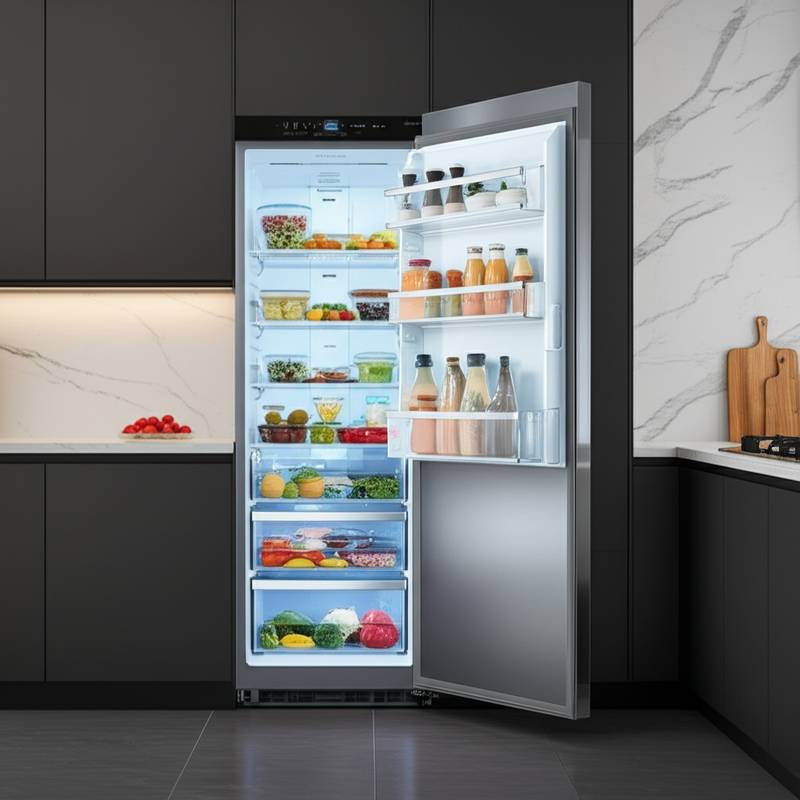Imagine opening your refrigerator and instantly knowing what ingredients you have, which items approach expiration, and what meals you can prepare before anything spoils. No more forgotten leftovers or buried produce. This scenario represents the emerging reality of smart kitchen technology, powered by artificial intelligence at its core.
Food waste occurs unintentionally in most households. People purchase items with positive intentions, yet busy schedules cause them to become overlooked, and expiration dates arrive unexpectedly. This leads to financial loss, environmental burden, and a refrigerator that induces guilt rather than support. AI-driven smart kitchens disrupt this cycle by functioning as personal assistants that observe, learn, and recommend.
Rethinking Food Waste in Modern Kitchens
Smart kitchens extend beyond isolated voice-activated appliances. They form interconnected ecosystems where refrigerators, ovens, and trash bins share data. AI enables these devices to identify food items, monitor freshness, and propose uses for existing inventory. The primary aims include minimizing waste, lowering costs, and enhancing cooking efficiency.
Smart refrigerators drive this shift. Current models feature internal cameras, barcode scanners, and machine learning algorithms that catalog items upon storage. These systems monitor expiration dates and issue alerts as limits near. Integration with grocery delivery services allows automatic reordering of essentials.
The Value of Fridge Cameras
Consumers often undervalue fridge cameras. Beyond mere visual monitoring, they pair with AI to analyze household patterns. For instance, if spinach consistently remains unused after two days, the AI suggests smaller quantities or early recipes featuring it. Such personalization distinguishes advanced smart fridges from basic connected ones.
Core Technologies Powering Smart Kitchens
AI in these kitchens combines sensors, image recognition, and predictive algorithms. Each element contributes uniquely:
- Sensors measure temperature, humidity, and weight variations. They assess freshness and detect if items move, open, or deteriorate.
- Image recognition catalogs refrigerator contents. Cameras capture grocery images, which AI matches to a food database.
- Predictive algorithms examine consumption habits. They identify regular items and schedule reminders for soon-to-expire ingredients.
These tools surpass basic automation. They foster environments that foresee requirements and avert overlooked spoilage.
Key Appliances for Everyday Impact
AI kitchen devices offer broad accessibility with varied pricing. Consider these options based on budget:
- Entry-Level: Samsung SmartThings Refrigerator (approximately $1,200). It provides internal cameras, app connectivity, and fundamental inventory management. This serves as an ideal introduction to smart systems.
- Mid-Tier: LG InstaView ThinQ Refrigerator (approximately $2,500). Double-tap the door for a peek inside without opening. AI evaluates contents, offers recipe ideas, and notifies of impending expirations.
- High-End: GE Profile Smart Refrigerator with AI Food Management (approximately $4,000). Deep learning identifies specific foods, links to meal planners, and generates customized grocery lists.
Select models compatible with existing setups. Integration with Google Home or Amazon Alexa ensures fluid appliance-app interactions.
Unseen Savings from Smart Features
Upfront expenses draw attention, yet true value emerges from waste reduction. Research indicates that AI food tracking lowers household grocery expenses by up to 20 percent. For typical families, this translates to substantial annual savings, plus the benefit of fully utilizing purchases.
Enhancing Cooking Through Real-Time Support
AI extends to ovens like the June Oven or Tovala Smart Oven. These use cameras and sensors to detect cooking items and optimize settings. Perfect results minimize under- or overcooking, preventing discarded meals.
Combining ovens with smart fridges forms a cohesive system. The fridge tracks available ingredients, the oven handles preparation, and apps suggest recipes prioritizing near-expiry items. This setup mimics a professional chef focused on efficiency and waste avoidance.
Predictive Meal Planning Tools
Predictive planning marks a key advancement. Apps such as Whisk and Yummly integrate with appliances to propose meals from on-hand ingredients. AI adapts to preferences and restrictions, streamlining planning and curbing excess purchases.
This approach cuts waste while easing daily choices. Less time on meal decisions allows more focus on preparing and savoring nutritious dishes.
Essential Steps for Implementing a Smart Kitchen
A connected kitchen holds appeal, but proceed strategically.
- Budgeting: Begin with one or two appliances. A tracking fridge or AI oven yields quick improvements without excess spending.
- Compatibility: Verify app and ecosystem support. Seamless device communication maximizes effectiveness.
- Privacy: Appliances gather habit data. Adjust settings and use secure Wi-Fi connections.
- Upkeep: Update software routinely and clean sensors for precision.
- Installation: For units needing plumbing or wiring, hire certified experts via platforms like HomeAdvisor or Angi.
Anticipating Spoilage with Advanced Detection
AI food management advances through chemical sensors detecting produce emissions. These identify rapid ripening and send app alerts. Premium models auto-adjust humidity to prolong shelf life.
This capability evolves rapidly. Soon, fridges will predict strawberry spoilage days ahead, prompting timely use.
Environmental Benefits of Reduced Waste
Waste reduction benefits individuals and the planet. Each preserved item conserves production, packaging, and transport energy. AI kitchens promote sustainability by merging convenience with responsible practices.
The process integrates seamlessly into routines. Kitchens adapt gradually, steering toward efficient, low-waste habits.
Steps to Build Your Smart Kitchen
To create an efficient, waste-minimizing space, initiate modestly. Identify a primary issue, such as ingredient tracking or cooking precision, and select a targeted device. Gradually incorporate supporting tools as familiarity grows.
Prioritize future-proofing when evaluating options. Supported appliances receive ongoing updates, refining performance based on your patterns.
Smart kitchens enhance rather than replace human involvement. They empower informed decisions on purchases, preparation, and enjoyment. Progress toward sustainability occurs one utilized ingredient at a time.
Frequently Asked Questions
How does a smart refrigerator track food expiration?
It employs image recognition, barcode scanning, and manual entries to log items, then cross-references with expiration databases.
What privacy measures should users take with smart appliances?
Review data policies, enable encryption, and limit shared information to essential functions.
Can smart kitchens integrate with existing voice assistants?
Yes, most models connect to systems like Google Home or Amazon Alexa for unified control.
